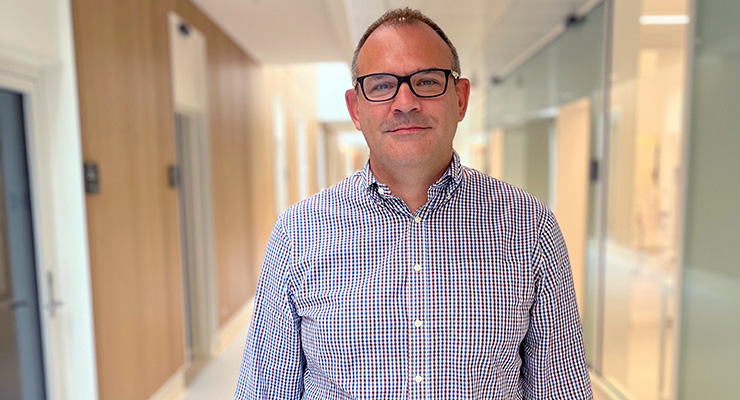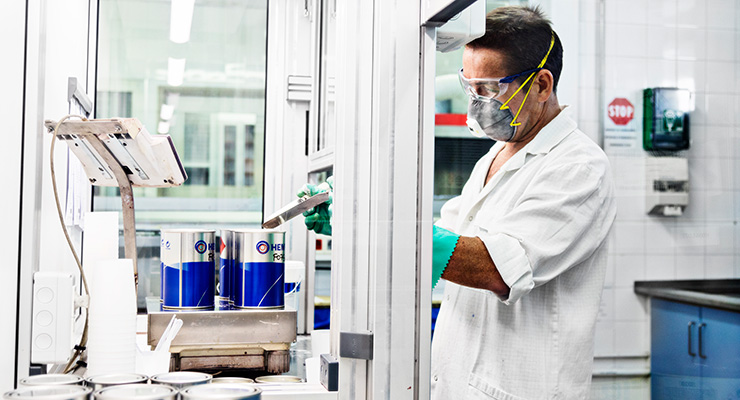10.16.23
Picture the scene: the year is 2050 and you’re crossing a bridge near Munich in southern Germany in your autonomous car, admiring the view. You don’t know it, but the bridge is a new lightweight steel design that’s being maintained while you cross it. Out of sight, autonomous beetle-like robots climb the bridge’s legs, scraping off the original coating so it can be 100% recycled back into new paint – a practice used worldwide. Drones fly behind, applying fresh surface protection to the newly-prepared steel.
When you arrive home, you flick on your living room wall with a swipe of your finger. The surface lights up – the entire wall an interactive screen. You pull up your calendar and check your messages. Then you adjust the wall behind you to display a calming forest scene.
This future scenario may seem far-fetched, but according to Nigel Shewring, who has headed up R&D at Hempel since 2019, some of these technologies are already under development and might be commonly used 20-30 years from now.
“The use of drones for coating removal and application in shipyards, where ships’ hulls can reach several stories, has been dreamed about for years. Now, together with our partners, we are working to make it possible on an industrial scale,” he says.
“There are challenges, of course, but there is no reason why this technology couldn’t be adapted to other more complex structures. One scenario we foresee is drones being operated remotely from a Hempel coating service center, so the specialists don’t even have to be onsite. The recycling of old coatings to extract raw materials is not too much of a stretch either. Already today, Hempel collaborates with a third party aiming to extract and reuse valuable raw materials from the surplus paint left at the bottom of cans.”
But for Nigel, exploring new possibilities comes with the job. He and his team are constantly connecting and collaborating with customers, suppliers, universities and partners from other industries to understand future trends and needs. Based on this work, Nigel is certain about one thing: in the future, paint and coatings will have multiple functions.
“It will no longer be enough for a paint to merely decorate and protect. Our natural resources are simply too limited. In the future, we won’t be able to afford to have a coating as well as a solar panel, for example. It’s just not sustainable. The coating will have to provide both functions – protect the surface and harvest free energy from the sun.”
This shift towards multipurpose coatings is already well underway. Hempel’s Hempaguard coating system, for example, protects the steel from corroding and improves the hydrodynamics of a ship’s hull to increase propulsion efficiency – which in turn lowers fuel consumption and CO2 emissions.
Since its launch in 2013, Hempaguard has been applied to more than 3,000 vessels, collectively saving the vessels’ owners over 9.2 million tons in fuel and reducing the vessels’ CO2e emissions by over 27 million tons. But there are many more multipurpose paints around.
Passive fire protection (PFP) coatings, for instance, improve fire safety by swelling when exposed to high heat to insulate the steel beneath. This enables the steel to maintain its load-bearing capacity for longer, so people have more time to evacuate the building and firefighters have extra time to put out the fire.
The next obvious evolution of this type of technology is to create exterior paints that swell and contract based on weather conditions. This would add extra insulation when needed, reducing heating and cooling requirements. “The benefits of this are obvious,” said Nigel, “as the most sustainable energy is the energy we don’t use.”
Hempel first began developing paints that ‘talk’ in 2018. Designed for large asset owners, such as oil and gas installations, these protective coatings have a sensor sandwiched in the coating scheme during application, which gathers data when the coating is in service. By continuously monitoring the coating and environmental conditions, the sensor informs the owner exactly when and where the coating needs to be repaired.
“As we begin to incorporate more sensors into coatings, our customers will be able to accurately predict asset lifetimes and enjoy much lower maintenance costs,” Nigel says.
Nigel is convinced that smart coatings are not just here to stay, but are an area with significant room for development.
“Right now, the sensors are embedded during application and monitor the coating after it has dried. But why not go one step further and incorporate the sensors into the coating during manufacturing so data can be captured throughout the production and distribution of the coatings. The data could be used by coating advisors to ensure that application and curing conditions are ideal, resulting in a longer coating lifetime.”
“Personalization is a big area in the home decoration market and I predict it will grow even more in the next decade or two. Paint could be used to create a huge canvas or interactive smart screen on the wall, for example, where homeowners can display video images, colors and patterns using integrated apps.”
Will homeowners apply this paint with a brush in 2050? Nigel doesn’t think so. “Home decoration will become much easier – dry-apply paints, for example, that are applied by a robot that you rent from the store,” he said.
To ensure Hempel remains at the leading edge of new developments, the company set up GrowHub in 2020. An internal incubator, GrowHub explores and facilitates the early-stage development of new ideas and technologies outside the can – working with other functions inside Hempel, as well as customers, technology companies and research organizations. The smart coating work highlighted the need for such a setup, and there are many more projects under development.
“At Hempel, we have an amazing Innovation team, but we simply can’t cover all areas and chase every opportunity, so we co-create with others. Whether it’s robotic paint application, paint recycling, sensors inside paints or something else, co-creation opens up new avenues that wouldn’t have been possible otherwise,” Nigel explains. “The urgent need to eliminate certain raw materials from finished products, accelerate the global energy transition and help minimize our customers’ environmental footprint has put innovation and product development on steroids. Partnerships across industries and research institutions are essential to stay ahead of the needs of our customers.”
“Organic solvents are a clear example of this,” he said. “I’m convinced that volatile organic compounds will be completely removed from paint in the not-too-distant future. I can actually imagine a scenario in which all liquid is removed. Today, the coatings industry ships a lot of liquid that doesn’t form part of the final dried film, whether that’s water or organic solvent. I think this will be removed to reduce costs and emissions from shipping and minimize packaging.”
Liquid-free paints already exist in the form of powder coatings but their wide-scale use remains limited, due primarily to curing constraints. Nigel can imagine many possible solutions to this challenge – from crayon-like paints that are smeared onto the surface to paint films that can be applied like interior wallpapers and then peeled off and recycled at the end of their lifecycle.
For Nigel, the future of paints and coatings remains a blank canvas, full of possibilities. He’s well aware that much of what he has described here may never come to pass – that, at any point, a new disruptive technology may come along that completely re-drafts the future.
But none of these developments would happen without people like Nigel and his dedicated team at Hempel, who are constantly imagining a brighter future with new sustainable coating solutions at its core.
When you arrive home, you flick on your living room wall with a swipe of your finger. The surface lights up – the entire wall an interactive screen. You pull up your calendar and check your messages. Then you adjust the wall behind you to display a calming forest scene.
This future scenario may seem far-fetched, but according to Nigel Shewring, who has headed up R&D at Hempel since 2019, some of these technologies are already under development and might be commonly used 20-30 years from now.
“The use of drones for coating removal and application in shipyards, where ships’ hulls can reach several stories, has been dreamed about for years. Now, together with our partners, we are working to make it possible on an industrial scale,” he says.
“There are challenges, of course, but there is no reason why this technology couldn’t be adapted to other more complex structures. One scenario we foresee is drones being operated remotely from a Hempel coating service center, so the specialists don’t even have to be onsite. The recycling of old coatings to extract raw materials is not too much of a stretch either. Already today, Hempel collaborates with a third party aiming to extract and reuse valuable raw materials from the surplus paint left at the bottom of cans.”
A More Sustainable World With Multipurpose Paints
Nigel is keen to stress that predicting the future is no easy task. He started in the coatings industry nearly three decades ago, in an office with a fax that was in almost constant use. Very few people back then would have predicted just how ubiquitous email would become – or that it would soon be replaced by videoconferencing and instant messages.But for Nigel, exploring new possibilities comes with the job. He and his team are constantly connecting and collaborating with customers, suppliers, universities and partners from other industries to understand future trends and needs. Based on this work, Nigel is certain about one thing: in the future, paint and coatings will have multiple functions.
“It will no longer be enough for a paint to merely decorate and protect. Our natural resources are simply too limited. In the future, we won’t be able to afford to have a coating as well as a solar panel, for example. It’s just not sustainable. The coating will have to provide both functions – protect the surface and harvest free energy from the sun.”
This shift towards multipurpose coatings is already well underway. Hempel’s Hempaguard coating system, for example, protects the steel from corroding and improves the hydrodynamics of a ship’s hull to increase propulsion efficiency – which in turn lowers fuel consumption and CO2 emissions.
Since its launch in 2013, Hempaguard has been applied to more than 3,000 vessels, collectively saving the vessels’ owners over 9.2 million tons in fuel and reducing the vessels’ CO2e emissions by over 27 million tons. But there are many more multipurpose paints around.
Passive fire protection (PFP) coatings, for instance, improve fire safety by swelling when exposed to high heat to insulate the steel beneath. This enables the steel to maintain its load-bearing capacity for longer, so people have more time to evacuate the building and firefighters have extra time to put out the fire.
The next obvious evolution of this type of technology is to create exterior paints that swell and contract based on weather conditions. This would add extra insulation when needed, reducing heating and cooling requirements. “The benefits of this are obvious,” said Nigel, “as the most sustainable energy is the energy we don’t use.”
Smart Coatings are the Future
Another future scenario that Nigel foresees is the rise of ‘smart coatings’ to extend coating lifetime and reduce maintenance requirements.Hempel first began developing paints that ‘talk’ in 2018. Designed for large asset owners, such as oil and gas installations, these protective coatings have a sensor sandwiched in the coating scheme during application, which gathers data when the coating is in service. By continuously monitoring the coating and environmental conditions, the sensor informs the owner exactly when and where the coating needs to be repaired.
“As we begin to incorporate more sensors into coatings, our customers will be able to accurately predict asset lifetimes and enjoy much lower maintenance costs,” Nigel says.
Nigel is convinced that smart coatings are not just here to stay, but are an area with significant room for development.
“Right now, the sensors are embedded during application and monitor the coating after it has dried. But why not go one step further and incorporate the sensors into the coating during manufacturing so data can be captured throughout the production and distribution of the coatings. The data could be used by coating advisors to ensure that application and curing conditions are ideal, resulting in a longer coating lifetime.”
Coatings as a Canvas
As well as performance coatings, Hempel produces decorative paints for DIY and trade, and has a number of brands under its portfolio, including Crown Paints, Farrow & Ball and Wattyl. When it comes to these decorative coatings, Nigel envisages a future in which smart coating technology is employed to create greater opportunities for personalization and design.“Personalization is a big area in the home decoration market and I predict it will grow even more in the next decade or two. Paint could be used to create a huge canvas or interactive smart screen on the wall, for example, where homeowners can display video images, colors and patterns using integrated apps.”
Will homeowners apply this paint with a brush in 2050? Nigel doesn’t think so. “Home decoration will become much easier – dry-apply paints, for example, that are applied by a robot that you rent from the store,” he said.
To ensure Hempel remains at the leading edge of new developments, the company set up GrowHub in 2020. An internal incubator, GrowHub explores and facilitates the early-stage development of new ideas and technologies outside the can – working with other functions inside Hempel, as well as customers, technology companies and research organizations. The smart coating work highlighted the need for such a setup, and there are many more projects under development.
“At Hempel, we have an amazing Innovation team, but we simply can’t cover all areas and chase every opportunity, so we co-create with others. Whether it’s robotic paint application, paint recycling, sensors inside paints or something else, co-creation opens up new avenues that wouldn’t have been possible otherwise,” Nigel explains. “The urgent need to eliminate certain raw materials from finished products, accelerate the global energy transition and help minimize our customers’ environmental footprint has put innovation and product development on steroids. Partnerships across industries and research institutions are essential to stay ahead of the needs of our customers.”
Beyond Liquid Paints
Whatever future you imagine, the coatings industry will be defined by how it adapts to these challenges. A healthy curiosity about new processes, combined with an ability to adapt, will be paramount and Nigel is convinced that the rate of change will increase exponentially as the world fully embraces the green transition.“Organic solvents are a clear example of this,” he said. “I’m convinced that volatile organic compounds will be completely removed from paint in the not-too-distant future. I can actually imagine a scenario in which all liquid is removed. Today, the coatings industry ships a lot of liquid that doesn’t form part of the final dried film, whether that’s water or organic solvent. I think this will be removed to reduce costs and emissions from shipping and minimize packaging.”
Liquid-free paints already exist in the form of powder coatings but their wide-scale use remains limited, due primarily to curing constraints. Nigel can imagine many possible solutions to this challenge – from crayon-like paints that are smeared onto the surface to paint films that can be applied like interior wallpapers and then peeled off and recycled at the end of their lifecycle.
For Nigel, the future of paints and coatings remains a blank canvas, full of possibilities. He’s well aware that much of what he has described here may never come to pass – that, at any point, a new disruptive technology may come along that completely re-drafts the future.
But none of these developments would happen without people like Nigel and his dedicated team at Hempel, who are constantly imagining a brighter future with new sustainable coating solutions at its core.





